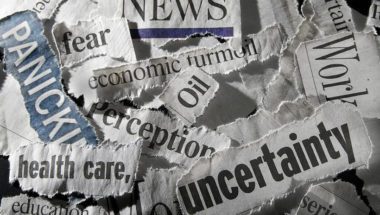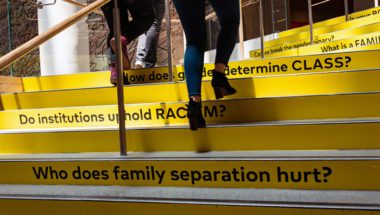There are many “unprecedented” things about the world today, and teaching news literacy in our current information environment is certainly one of them. Never before have there been so many news and “news-like” sources from which to receive information. As a result, news consumers of all ages express frustration, confusion, and resignation over which ones to trust. However, citizens who care about having a free, just, safe, and fair society know that we cannot simply throw our hands up in despair. It is imperative that we collectively rise to the challenge of navigating our news environment to ensure that we continue to progress toward those worthy goals. This post discusses what makes teaching news literacy so unique today and provides strategies for success in spite of all the challenges.
A Changing News Landscape
Those whose professions charge them with teaching information literacy (especially media literacy and news literacy) find themselves dealing with some threshold challenges due to the change in the news landscape over the last 60 to 70 years. Difficulties in navigating the news landscape differ for people of different generations, who have each lived through larger or smaller portions of those last 60 to 70 years. In the 1950s, ‘60s, and ‘70s, there were only a handful of news sources: a few large national papers, a few local papers, and the three main TV broadcast networks. The ‘80s and ‘90s brought cable news channels and a 24-hour news cycle; the late ‘90s and early 2000s brought news publishing online and rapid proliferation of new sites, and the 2010s brought smartphones, social media, and search platforms that combined to unleash an explosion of new news and information sources.


Such rapid change has been jarring for those old enough to remember the days of the handful of papers and three broadcast news networks, which include Baby Boomers, Gen Xers,
and some older Millennials. In contrast, younger Millennials and Gen Z have always lived in a world where there are thousands of news sources at their fingertips. It is certainly possible that the changes one has lived through in the media landscape affect one’s level of trust in it. Though trust in news media is generally low across all age groups, trust among those under 35 is lowest. Relatedly, a 2019 study showed that older Americans are more likely to share fake news online than younger ones. Though many factors likely influence how much any group of people trust various news sources, these studies and surveys suggest that while large segments of our population distrust the media, older Americans may tend toward trusting too much while younger ones may tend toward trusting too little.
Challenges for Educators
Educators themselves span each of these generations. The most obvious resulting problem educators face given the overwhelming number of news sources is how to discern between reliable and unreliable sources themselves in order to teach their younger “digital native” students how to discern. That is, if you are not quite sure how you know how to trust something, how do you teach your students how to know?


Another challenge of our modern media landscape is that not only is it overflowing with sources, it is also hyperpolarized. News sources do not just have reliability problems—they have bias problems as well. As a result, teaching news literacy today inherently requires teaching about biased sources and therefore requires bringing difficult political subjects into the classroom. There are many valid reasons educators may want to avoid bringing politics into their classrooms, such as a desire to maintain professionalism by limiting their own expressions of bias, a desire to avoid bringing up topics that may be personally sensitive to some students (e.g., race, abortion, immigration), and a desire to avoid accusations of political motivations by bosses, colleagues, school boards, students, or parents.
The Media Bias Chart® as a Key Tool to Teach News Literacy
About four years ago, I created the first version of the Media Bias Chart®, and almost immediately, educators started using it in classrooms, libraries, reference guides, and textbooks. During those four years, I have created and refined its taxonomy and methodology, talked to hundreds of teachers, professors, and librarians about how they like to use the Media Bias Chart, trained dozens of analysts on how to rate news articles for reliability and bias, developed a news literacy software platform for educators and students called CART (Content Analysis Rating Tool), and trained dozens of educators how to use that platform to teach news literacy in a way that effectively addresses the needs and challenges of our modern news environment.
Naturally, I suggest incorporating the Media Bias Chart as a key tool to effectively teach news literacy, and some of the recommendations I provide herein are related to it. However, these recommendations go beyond simply using the Media Bias Chart and are derived from experience I have had talking to educators. This experience has given me insight into the particular challenges I have described in this post—namely, how to know what sources to trust yourself, and how to navigate bringing difficult political topics into the classroom.
How to Know What to Trust
This is the number one question I get from every audience. The reasons I get this question are because there is no simple answer to it, and because it is on nearly everyone’s minds these days. These are the same reasons the Media Bias Chart is so popular—it provides a reasonably good shortcut to the question of “how to know what to trust.” For the purposes of teaching literacy to others—especially to others who are skeptical—a couple of key principles can help people determine what’s true on their own, which is far better than asking them to blindly rely on a third party they don’t know (i.e., us at Ad Fontes Media, who created the chart). Each of these trust principles is related.
1. Read laterally


A 2017 study by researchers at Stanford found that people who read laterally—meaning study participants who tried to verify whether something they read was true by looking at other information sources to corroborate the facts or stories they were reading about—were able to distinguish what was true much more reliably and much more quickly than those who looked for clues only within the first source they were examining.
In our experience rating news articles for reliability, lateral reading is the most valuable tool we use. Our analysts are not fact-checkers, and teachers, students, and most citizens are not fact-checkers, yet we all still need to be able to reasonably determine whether what we read is likely to be true in a short period of time. Lateral reading allows you to rely on the hardworking journalists and fact-checkers we do have in our robust news ecosystem and come to reasonable conclusions about veracity quickly.
Lateral reading also helps you understand whether what you are reading is biased, because multiple articles about similar topics will inherently have differences in what they present.
2. Have a “basket of reliable sources”
People often ask me, “Which news source can I always trust?” I answer that you shouldn’t just have one news source, but rather several go-to sources to cross-reference. It is difficult to rely on just one source because all news sources are run by humans, and they all (even the best ones) make mistakes from time to time. Usually, if one makes a mistake, you can find out about it through reporting by another source in your basket of reliable sources. Another reason it is difficult to rely on just one source is that no one news source can cover every single story out there.
Ideally, you should develop at least 10 news sources you can rely on. Over time, you should seek to expand that basket of reliable sources by reading new sources and cross-referencing the veracity of their stories with the reliable sources you already know. New news sources come into existence quite frequently, and some are quite good, but new ones need to earn their reputation with you over time.
3. Look up things you have reason to question
We are fortunate to live during a time where all the world’s information is more accessible to each of us than ever before. Not only do we have the services of several dedicated and reputable fact-checking organizations such as Politifact, Snopes, Factcheck.org, Poynter, and others, but we also have hundreds of reliable journalism outlets, and we have modern search engines like Google. We can find background information on nearly everything we could possibly read in a news article. The most information literate among us develop habits of looking up that information often.
We all get that feeling sometimes that something we are reading might not be true. Whenever that happens, just look it up. Looking it up is similar to lateral reading (where you look for another news story about what you just read) but is broader. You can and should look up anything you can question—an author, an image, a video clip, an embedded link—anything that can give you additional insight about what you need to know.
It is a good habit to look things up when you feel that something you are reading might not be true, but if you find yourself rarely questioning the truth of what you read, there are some habits you can develop to become better attuned to things you should be questioning. The two most common types of information you should question are the following:


- Information you haven’t heard anywhere else yet which is “big, if true.” That is, if something sounds like it is groundbreaking, a bombshell, a big deal, or shocking, you should look it up to verify whether it is true. If it is, it will be re-reported in other reputable sources. Be wary of any sources that claim to be the only ones really telling you the truth about something big.
- Information that confirms your biases and makes your political opponents look bad. This sort of information is designed to be highly appealing, engaging, and shareable, but it is often the sort that is not entirely true.
How to Navigate Bringing Politics into the Classroom


Many adults have deeply divided views due to the highly polarized information they consume, which has led to political dysfunction. Knowing this, many educators feel that teaching students about bias is more important than ever, especially since the students may be learning about certain political issues for the first time and since they are inexperienced at differentiating between news sources. At the same time, the polarization among adults makes teaching political topics in the classroom more controversial than ever.
I have spoken to audiences having members with greatly varying political viewpoints, and I have found the following principles to be critical to fostering open-mindedness, understanding, and respectful dialogue:
1. Remind students about each other’s humanity
People often forget that political issues are fundamentally about how government policies affect the real, lived experiences of individual human beings. Polarizing junk news tends to generalize and abstract issues, and often vilifies and dehumanizes political opponents. Before bringing up political issues in the context of news literacy, it can be helpful to remind students how the political topic might affect the lives of their classmates. For issues such as immigration, abortion, health care, and racial injustice, for example, it can go a long way to give examples of how particular life experiences can shape one’s views on the issues.
2. Have students decide how they would rate news sources
The Media Bias Chart is a useful shortcut to finding out, at a glance, where Ad Fontes Media, a third party, rates news for reliability and bias. It serves as a nice baseline for finding sources one can rely on, which is especially helpful for people who are unfamiliar with many sources across the news landscape. However, for teaching news literacy, it is most useful as a mere starting point. Real news literacy happens when students use the Media Bias Chart as a framework for doing their own critical thinking to evaluate news sources themselves.
By placing the focus on having students evaluate news sources themselves, one can avoid backlash and accusations of bias from those who instinctively disagree with Ad Fontes Media’s ratings of certain news sources. I believe it is always better for people to think and evaluate for themselves anyway, and students, teachers, administrators, school boards, and parents tend to be more receptive to overall news literacy concepts if the focus is on students figuring out themselves, rather than someone telling them, what news sources are unreliable and biased.


I believe we are in a temporary moment when our society’s technological ability to distribute information has surpassed our individual abilities to process it. However, this has happened in history before, with the inventions of the printing press, radio, and TV. Each time, we have adapted, and the increase in information exchange has proven to be a net benefit to society. I’m optimistic that we can rise to the challenge again, because we must. Even though the challenges to teaching news literacy are real, daunting, and yes, unprecedented, I hope you take them on because of the difference you can make.
Interested to learn more? Register for our upcoming webinar with Vanessa Otero, Thursday, September 10, 2020, at 3:00 p.m. ET: Teaching News Literacy Through Polarizing Current Events
Also, check out our webinar Navigating the News Landscape with the Media Bias Chart, where Vanessa Otero discusses how to use the Media Bias Chart framework to teach news literacy in various educational settings, from simply using it as a reference resource to teaching students how to place news articles and sources on the chart themselves.

